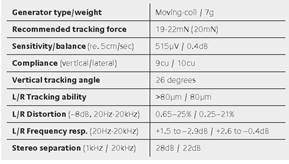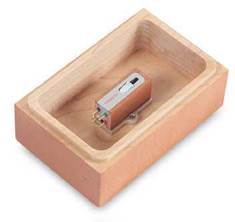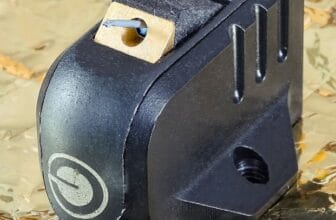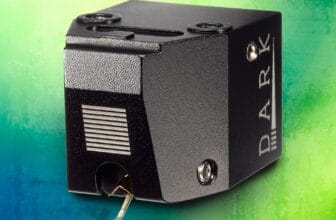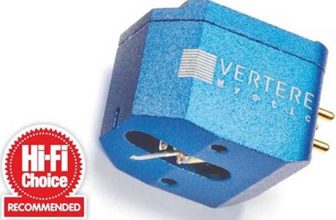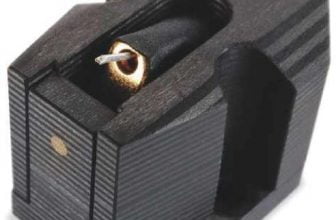Sumiko Pearwood Celebration II review
With nearly a half century of MC experience under its corporate belt, Sumiko knows how to optimise pick-up performance: enter the Pearwood, an MC that tracks like an MM. Read our Sumiko Pearwood Celebration II review.
Review: Jonathan Gorse Lab: Paul Miller
Medium-output moving-coil cartridge Made by: Sumiko, Minnesota USA Supplied by: Henley Audio Ltd, UK Telephone: 01235 511166 www.sumikoaudio.net; www.henleyaudio.co.uk
Since it was founded in 1972 by noted audio designer David Fletcher, the US-based Sumiko Corporation has been making some of the world’s most desirable pick-ups at its production facility in Japan. What’s more, not only has it become one of the leading agents for audio equipment in North America but its UK presence has recently been boosted by distributor Henley Audio [see PM’s boxout, p55].
Its current cartridge range comprises two tiers: the midrange Oyster series, which includes affordable moving-magnet and moving-coil designs, and the high- end Reference series. Within the latter are six diverse models ranging from the Songbird to the range-topping Palo Santos Presentation [HFN Jul ’10] complete with rosewood body and line-contact stylus. The Pearwood Celebration II lies second from the top and shares many features with the Palo flagship, Sumiko positioning it as a design that offers more than a taste of its ultimate offering but at a more affordable price.
FORBIDDEN FRUIT
At this rarified level, presentation is an important part of the overall ownership experience and this cartridge doesn’t disappoint. Not only is its body crafted from the wood from which it derives its name, but so also is the presentation box in which it is supplied. Pearwood is an expensive timber because most pear trees are grown for their fruit, which means few are felled to satisfy the demands of discerning audiophiles!
The cartridge is supplied with a very comprehensive 35-page manual detailing its genesis, an explanation of the design choices made and extensive guidance notes on how to set-up the cartridge for best performance. Unwrapping a pick-up that has been output [see PM’s Lab Report, p57], Sumiko trading a little extra moving (coil) mass for compatibility with a wider range of phono preamps. In particular, Sumiko highlights designed and hand crafted with such abundant care evokes feelings of delight and expectation, albeit tempered by the discovery there’s no stylus guard!
On paper, the Sumiko Pearwood Celebration II has a relatively generous 0.5mV
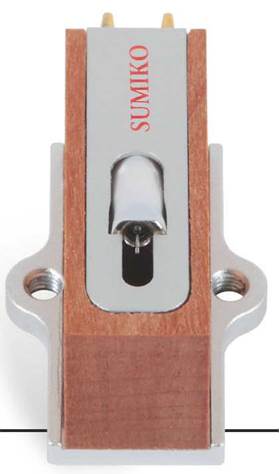
RIGHT: Despite the modest 2.0g downforce and low compliance, but assisted by a boron cantilever and Ogura diamond, the Pearwood has the tracking prowess of a lightweight MM
the greater risk of hum, noise and RFI pick-up when a high-gain phono stage is combined with a very low output MC. For the Pearwood Celebration II, output is
‘The effect is Wagnerian, but nightmarish for cartridges’
boosted by a substantial AlNiCo magnet assembly and front yoke, precisely pressure-fitted to ensure a uniform magnetic field. The cantilever is a refined long-grain boron rod supporting an ultra- low-mass Ogura Jewel
Company P9 solid-diamond elliptical stylus. An elliptical profile was chosen in preference to a line-contact or Shibata type because Sumiko believes those more exotic profiles require very precise tonearm alignment, which is difficult to achieve under all but the most fastidious (read impractical) of conditions.
A FINE FIT
Sumiko also suggests that an elliptical stylus still delivers a very musical sound even when not aligned to laboratory standards, bringing benefits to ‘real world’ audiophiles. Meanwhile, the cartridge’s straight-sided rectangular body affords easy alignment, although it’s quite shallow and correct VTA put the rear of my SME IV’s tapered arm tube quite close to the record edge. A headshell shim and record clamp to flatten any warps are two useful accessories with these tapered SME arms!
Otherwise, the cartridge body is tapped for standard M2.5 mounting bolts and a sound coupling between the arm and cartridge is assured via its Teflon-coated aluminium bonded mounting plate.
Sumiko is at pains to point out that the cartridge can accommodate a wide range of preamp loads from 100-1000ohm thanks to its internal impedance of 30ohm. The body weighs 7.0g and optimum tracking force is specified at 2.0g while its compliance characteristics indicate that it would suit the majority of high-quality medium or high-mass tonearms.
Production levels of such an esoteric design are necessarily low due to the labour-intensive hand-built nature of the product. This artisan approach carries through to the testing and QC procedure – each cartridge is subjected to a battery of test records, is individually auditioned and is hand-calibrated prior to dispatch. Sumiko argues that only by such intensive attention to detail in the hands of a master craftsman can the very highest levels of performance be achieved.
© ROCK STAR
My resident Michell GyroDec turntable and SME IV arm proved ideal partners for the Pearwood Celebration II while a PS Audio
Stellar Phono [HFN Feb ’20] offered all the loading and gain options I could wish for. The remainder of the test system included Naim NAC82/HICAP/NAP250 amplification driving ATC SCM40 speakers.
Let me put my cards on the table – when it comes to cartridge performance, I seek neutrality. That means clear vocals, acoustic guitars and violins that reveal their timbres, not to mention drums that have all the attack and solidity of the real thing. And from the very beginning that’s exactly what the Pearwood Celebration II delivered. There was a feeling of superb clarity and detail that never descended into harshness or cacophony. There was a sense of rock-solid stability underpinned
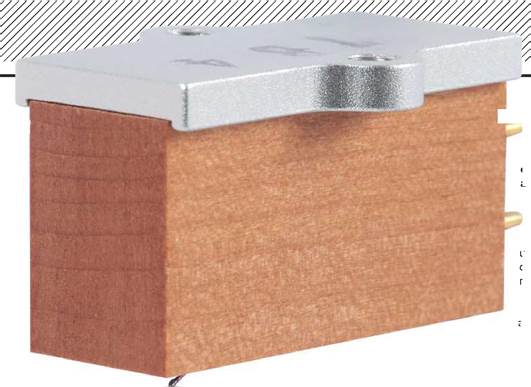
LEFT: Although the magnet, yoke and ‘moving-coil’ assembly are mounted into a rigid alloy chassis and top plate (with threaded lugs), the 90° angles of the decorative Pearwood sleeve are a boon for accurate alignment. Cueing is a little trickier
by a soundstage that proved as immovable as a Stonehenge obelisk. These qualities of stability and unflappability encouraged me to delve deep into my record collection with nothing proving off limits. Even torture tracks and poorly recorded albums were rendered with a rare panache, and U2’s Joshua Tree [Island 208 219] is a fine example of this. While an enjoyable album musically, it suffers from an over-compressed mix that can sound both shrill and muffled at the same time. The experience is akin to listening to music with a permanent head-cold – perhaps that’s the effect producer Daniel Lanois was seeking, though somehow I doubt it.
TORTURE TRACK
Hearing ‘Trip Through Your Wires’ via the Pearwood Celebration II was a revelation, with the opening harmonica beautifully rendered without loosening my fillings as usual. Better than that, the whole LP actually sounded like a band in a room, there being a good sense of acoustic space while Larry Mullen’s drum kit had some weight behind it, if still lacking some kick.
It’s a good example of how the Sumiko Pearwood Celebration II allows you to enjoy more of your record collection. As a further blessing, surface noise was commendably low and the cartridge tracked like it was on rails, just as predicted by PM’s lab tests [p57].
One torture track I longed to play was the 12in mix of ‘This Corrosion’ by The Sisters Of Mercy [WEA MR39T] – a song so explosive in its delivery it feels as if it might set fire to the GyroDec every time I spin it! The band fielded the massed choir of The New York choral society – all 40 of them – and backed them with soaring distorted guitar and a pounding drum beat. The effect is Wagnerian and yet the stuff of nightmares for a diamond to track cleanly in a groove. Every cartridge I have ever used on the GyroDec in 21 years has sounded like it was screaming for mercy, neither able to reproduce the voices cleanly nor maintain control over the proceedings. This time it
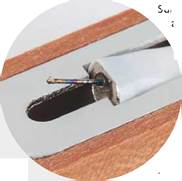
FROM MICRO TO MACRO
I discussed the history of Sumiko’s design and distribution business in our review of the Starling [HFN Mar ’20]. Today Sumiko is a brand as comfortable with the micro-engineering of an Ogura Jewel Company P9 stylus and long-grain boron
cantilever (see inset picture) as the macro-engineering of its S series active subwoofers. So bass enthusiasts may well recognise the Sumiko name, as it also has a history selling high-performance subwoofers for hi-fi and home theatre applications. Finding one available might be a tall order, however – a separate entity to Sumiko Phono Cartridges, Sumiko’s subwoofers haven’t been picked up for UK sale by distributor Henley Audio.
Once an agent of North American sub-bass specialist REL Acoustics, more recently Sumiko partnered with Italian marque Sonus faber to produce a four- strong range. This kicks off with the compact S.0 – an affordable 6.5in/120W Class AB design – before advancing in driver size and onboard power to the top-of-the-range S.10, which partners a 12in driver with 12in passive radiator, and claims 1kW peaks from its Class D amplifier module. Adopting the tagline ‘musical subculture’, Sumiko positions its subs as ideally suited for two-channel stereo systems – think definition, speed and nuance rather than the infrasonic depth and sheer slam of more home cinema-focused models. PM
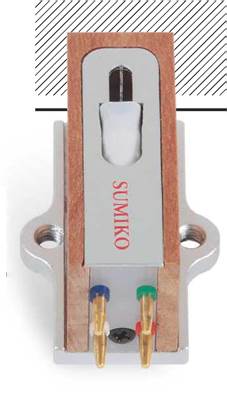
RIGHT: Colour-coded and tapered cartridge pins emerge from a Teflon plate. The black bolt clamps the magnet assembly into the alloy body
was different, and where once there was chaos now there was order. The massed choir soared cleanly in the huge acoustic space of an imaginary cathedral while it was easy to pick out the intricate bass line behind the beat. Despite the track’s complexity, the Pearwood Celebration II demonstrated incredible slam, precision and attack, which served to emphasise the sheer power and energy of the performance.
In short, the Pearwood Celebration II was absolutely dazzling and I have never heard The Sisters sound better. This is what great audio design is all about. All those years spent saving for an upgrade and worrying about synergy and turntable set-up resolve down to this – one perfect track, one night and tears in your eyes…
REAL DEAL
Playing Belle And Sebastian after that really was moving from the ridiculous to the sublime, but Days Of The Bagnold Summer [Matador Ole-1455-1] and ‘I Know Where The Summer Goes’ is as pure a slice of pop heaven as it’s possible to find. Glorious Hammond organ underpins the track to a shuffle beat and Stuart Murdoch’s plaintive vocals are wonderfully expressive. As the timbre and sonority of Sarah Willson’s cello poured from my speakers, this cartridge left no stone unturned in revealing forensic details of the piano buried low in the mix.
ABOVE: The Pearwood Celebration II arrives in a fragrant wooden box, but be careful when unpacking and installing because no stylus guard is supplied
On other tracks, such as ‘Sister Buddha (Intro)’, the Pearwood Celebration II presented the strummed acoustic guitars with startling transparency and the accompanying bass guitar with a wonderfully ripe fullness. The perceived bandwidth is wide, and there’s a sense of neutrality, of nothing being added or taken away. It was rather like sitting in the control room in the studio, listening to a playback with the band.
Electric guitar can certainly be a challenging instrument to reproduce yet on ‘Once Upon A Time In The West’ from Dire Straits’ second studio album Communique [Vertigo 6360170] Knopfler’s signature Stratocaster sound was astonishingly textured and real. A true virtuoso, every string-bend and nuance of his playing was laid bare while other instruments in the mix were clearly delineated. Yet none of this was ever at the expense of presenting the song as a cohesive whole.
VERDICT
Read our MOVING-COIL CARTRIDGES GROUP TEST
LAB REPORT
SUMIKO PEARWOOD CELEBRTN. II
Although we recently looked at Sumiko’s Starling MC [HFN Mar ’20] the Pearwood Celebration II bears closer comparison, in both design and performance, to the flagship Palo Santos Presentation [HFN Jul ’10]. Both cartridges feature a wooden sleeve, an AlNiCo magnet and long-grain boron cantilever but the ‘ultra low mass’ 75x5pm line contact diamond used by the Palo Santos is traded for an elliptically-ground P9 stylus from the Ogura Jewel Company in the Pearwood. Both cartridges have a slightly high 25-26o VTA at their recommended 2g downforce but both offer a flatter HF response, and better L+R/L-R symmetry than the Starling. The Pearwood’s low/mid frequency response (20Hz-2kHz) is flat to within ±0.5dB leaving the output to peak at +1.1dB [L-R, red trace, Graph 1] and +2.6dB [L+R, black trace] above 10kHz [see Graph 1, below]. This is unlikely to cause audible brightness or emphasise surface noise, just as the ~20% peak in equalised distortion (-8dB re. 5cm/sec) at a similar 15kHz [Graph 2] will add no ‘coarseness’. The THD is simply a reflection of the Pearwood’s very extended HF response.
Like the Palo Santos, the Pearwood has a relatively low 9-10cu compliance and yet it boasts the tracking prowess of a lightweight MM. Few MCs surpass the 80pm groove test but the Pearwood steps up and tracks through. Via the stepped 300Hz test tracks, the Pearwood suffers just 0.2% distortion at +6dB (re. 5cm/sec), increasing to a mere 0.8% at the maximum +18dB modulation. Once again, few 10cu MCs will get past the +15dB grooves. Tracking assured, the 0.5mV cartridge output (into 100ohm) is achieved with a wide 25dB+ midband channel separation and a channel imbalance of just 0.4dB. PM
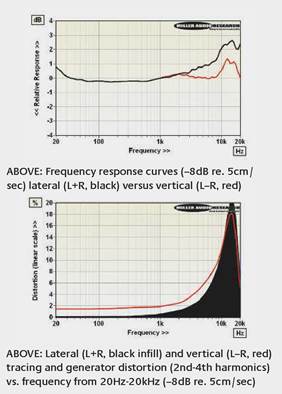
SPECIFICATIONS
